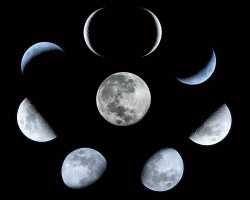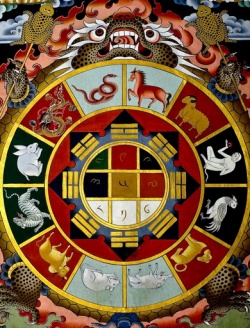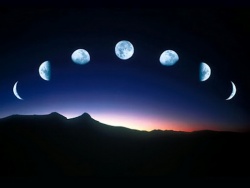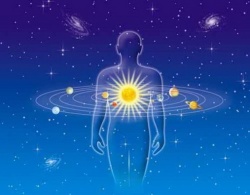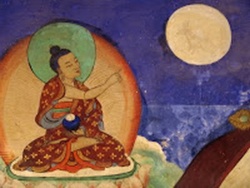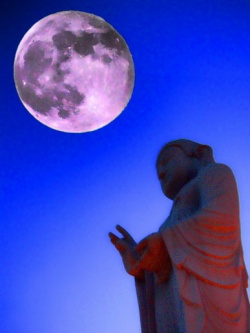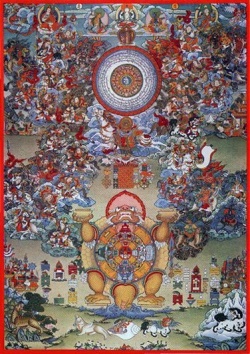Difference between revisions of "Co-ordinating Practice with the Moon"
m (Text replacement - "]]]" to "]])") |
|||
| (24 intermediate revisions by 4 users not shown) | |||
| Line 1: | Line 1: | ||
[[File:MOON PHASES14.jpg|thumb|250px|]] | [[File:MOON PHASES14.jpg|thumb|250px|]] | ||
<poem> | <poem> | ||
| − | In most (but not all) cultures, the {{Wiki|sun}} is considered male and the | + | In most (but not all) cultures, the {{Wiki|sun}} is considered {{Wiki|male}} and the {{Wiki|moon}}, {{Wiki|female}}. In {{Wiki|Japanese}} [[mythology]] it is the reverse, and it is the same in the [[Vajrayana]]. |
| − | + | Here, the {{Wiki|sun}} stands for [[Wisdom]] (Skt.: [[prajna]]) portrayed as a {{Wiki|female}} [[deity]], and the {{Wiki|moon}} is Method ([[upaya]], "[[skillful means]].") This [[tradition]] bears some [[relation]] to the [[celestial]] [[bodies]] as they are associated with the [[Indian]] [[gods]], {{Wiki|Shiva}} and {{Wiki|Parvati}}. So the round {{Wiki|sun}} sitting in the curve of the [[new moon]], a motif often seen as the finial or peak of a [[stupa]], conveys that [[tantric]] [[meaning]] which concerns the [[union of Method and Wisdom]]. Both [[celestials]] appear at the top of many [[tangkas]] -- the {{Wiki|moon}} is to the main [[deity]]'s right and the {{Wiki|sun}} to its left. | |
| − | [[Khenpo Karthar Rinpoche]] says, about practice at the new and full moons: | + | Besides this, in {{Wiki|lunar phases}} there is an obvious association with the monthly cycle of {{Wiki|fertile}} women. In many {{Wiki|cultural}} [[traditions]], the {{Wiki|lunar cycle}} is believed also to affect everyone in {{Wiki|subtle}} ways. Within the [[yogic]] or [[vajrayana]] system which concerns the "aetheric" or [[Vajra body]], different times of the {{Wiki|lunar cycle}} have different benefits relating to the circulation of the [[winds]] in the [[channels]]. |
| + | |||
| + | [[Khenpo Karthar Rinpoche]] says, about practice at the new and [[full moons]]: | ||
"These days are not only important within the [[Vinaya]] context, but from the [[Vajrayana]] [[view]] they are even more important. | "These days are not only important within the [[Vinaya]] context, but from the [[Vajrayana]] [[view]] they are even more important. | ||
| − | From the [[Vajrayana]] | + | From the [[Vajrayana]] [[Buddhist]] [[tantric]] point of [[view]], the change of the {{Wiki|sun}} and the {{Wiki|moon}} produce a change of the [[elements]] and thus a shift or change in the [[elements]]/{{Wiki|planets}}. While there is a shift in the more [[physical]] sort of gross level (the [[physical]] [[elements]] of the [[body]]), there is also a shift on a more {{Wiki|subtle}} level, a shift in the [[wisdom]] [[mind]] -- potential [[enlightened mind]] ... . There is a push that is in some [[sense]] taking place ... . [[Being]] able to engage in the practice of the [[Dharma]] is very very important on such occasions. There is a shift. There is a change ... for a [[practitioner]] who uses this [[time]] for practice, this kind of intense [[time]] for practice can be of the [[highest]] {{Wiki|benefit}}, of greatest {{Wiki|benefit}}. |
| − | During these times, access to potent qualities are at your disposal more than on regular occasions. If you put them to [[wholesome]] use, then greater benefit." | + | During these times, access to potent qualities are at your disposal more than on regular occasions. If you put them to [[wholesome]] use, then [[greater]] [[benefit]]." |
[[File:Mooned6efc.JPG|thumb|250px|]] | [[File:Mooned6efc.JPG|thumb|250px|]] | ||
| − | {{Wiki|Shiva}} the [[Indian]] "[[Hindu]]" [[god]] who is a [[yogi]] himself, and the patron of [[yogis]] is sometimes depicted with a [[mala]] or garland of a month of moons around his neck. He wears a crescent | + | {{Wiki|Shiva}} the [[Indian]] "[[Hindu]]" [[god]] who is a [[yogi]] himself, and the {{Wiki|patron}} of [[yogis]] is sometimes depicted with a [[mala]] or [[garland]] of a month of moons around his neck. He wears a crescent {{Wiki|moon}} as an ornament in his [[hair]]. |
| + | |||
| + | |||
[[Uposatha]] | [[Uposatha]] | ||
| − | [[Full Moon]] and [[New Moon]] times, the appearance of the first crescent and so on, have been marked probably since [[time]] immemorial, by the performance of various [[rites]] of confirmation or [[spiritual]] re-dedication and [[purification]]. | + | [[Full Moon]] and [[New Moon]] times, the [[appearance]] of the first crescent and so on, have been marked probably since [[time]] immemorial, by the performance of various [[rites]] of confirmation or [[spiritual]] re-dedication and [[purification]]. |
| + | |||
| + | In cultures where the [[lunar]] [[calendar]] is still observed, often the new month is considered to begin at the waxing half-moon. | ||
| − | + | In the [[Theravadin]] [[Buddhist]] lands such as [[Thailand]], for instance, the [[eighth day]] in both bright and dark halves of the month (quarter-moon day) is regarded as an appropriate [[time]] for [[gathering]] for [[dharma]] teachings. | |
| − | These are the [[Uposatha]] days that are observed by [[Theravadin]] [[Buddhists]], both [[ordained]] and laity. Householders and other non-monastics undertake the observance of the eight lay [[precepts]] or [[vows]] for the night and the day that they are at the [[monastery]] or [[temple]]. [[People]] of all [[Buddhist]] [[traditions]] can occasionally decide to do that; some keep these [[vows]] for periods of up to a [[lifetime]]. | + | This {{Wiki|custom}} stems from before [[Buddha's]] [[time]], when the various groups of [[ascetics]], [[yogis]] and [[philosophers]] used those special days for the [[teaching]] and promoting of their various theories and practices. Therefore, the [[Buddha]] encouraged [[bhikshus]] and [[bhikshunis]] to use that day to [[gather]] together for the {{Wiki|recitation}} of their [[pratimoksha]] and [[monastic rules]], but also for the [[purpose]] of [[teaching]] the [[dharma]] to [[lay people]] who would go to the [[monastery]] for that [[purpose]]. |
| + | |||
| + | These are the [[Uposatha]] days that are observed by [[Theravadin]] [[Buddhists]], both [[ordained]] and laity. Householders and other non-monastics undertake the [[observance]] of the eight lay [[precepts]] or [[vows]] for the night and the day that they are at the [[monastery]] or [[temple]]. [[People]] of all [[Buddhist]] [[traditions]] can occasionally decide to do that; some keep these [[vows]] for periods of up to a [[lifetime]]. | ||
[[File:839-hd.jpg|thumb|250px|]] | [[File:839-hd.jpg|thumb|250px|]] | ||
| − | |||
| − | Most other [[Buddhist]] [[traditions]] are also determined by the phase of the | + | The 8 lay [[precepts]] are: |
| + | |||
| + | to refrain from {{Wiki|killing}} [[living beings]], | ||
| + | |||
| + | refrain from taking what is not given, | ||
| + | |||
| + | refrain from {{Wiki|sexual}} [[activities]], | ||
| + | |||
| + | refrain from false [[speech]], | ||
| + | |||
| + | abandon distilled and fermented [[intoxicants]], | ||
| + | |||
| + | refrain from eating outside the one mid-day mealtime, | ||
| + | |||
| + | refrain from [[trivial]] pursuits ([[dancing]], singing, playing {{Wiki|music}}, going to shows, wearing ornaments, [[perfumes]] or [[cosmetics]],) and to | ||
| + | |||
| + | refrain from using raised or wide beds. | ||
| + | |||
| + | Most other [[Buddhist]] [[traditions]] are also determined by the phase of the {{Wiki|moon}}. For example as in {{Wiki|Laos}}, [[Pavalana]] or The [[Prior Notice ceremony]] is on the evening of the [[full moon]] of the fifteen day in the eleventh month. This is one day before the end of the {{Wiki|monsoon}} ([[Indian]] [[rainy season]]) [[retreat]], or what some call "[[Buddhist]] Lent." | ||
| + | |||
| + | [[Pavalana]] means "giving warning, or [[notice]]" and that is the [[time]] the {{Wiki|community}} expects to hear from the [[monastics]] whether they need any of the "4 main requirements": [[food]], clothing, bedding, [[medicine]], plus any other thing. This giving [[notice]] includes the [[monastics]]' [[duty]] to warn and advise each other of unmindful {{Wiki|behaviour}} and infractions of the {{Wiki|rules}} before they leave again to wander for the rest of the year. | ||
| + | |||
| + | The oldest member asks for advice first, and they all take turns using the [[Pali]] [[formula]] that, translated says: | ||
| + | |||
| + | "All the [[monks]], please listen to me. Since today is [[full moon]] day, we give prior [[notice]] that we have completed our practice according to the [[Buddha]]. Please advise me since there is no [[doubt]] that I have made mistakes and breeched [[monastic]] {{Wiki|rules}}; please warn me so I can change my bad {{Wiki|behaviour}} and act in the proper way." ~ {{Wiki|Mekong}} Centre | ||
| − | |||
| − | |||
[[Dakini]] Days | [[Dakini]] Days | ||
| − | The two "tenth" days (the 10th and the 25th which fall at the [[time]] of the moon's crescents) are considered conducive to the gathering of | + | The two "tenth" days (the 10th and the 25th which fall at the [[time]] of the [[moon's]] crescents) are considered conducive to the [[gathering of dakinis]]. Practitioners of [[Mother Tantras]] and some [[Nyingma]] [[traditions]] hold a [[tsok]] or feast. |
| + | |||
| + | ([[Nyingmapas]] focus on [[Guru Rinpoche]] surrounded by his [[dakini]] retinue on those [[lunar]] days. | ||
| + | |||
| + | [[Full Moon]] is [[Amitabha]] Day. | ||
| + | |||
| + | The 29th (the dark of the {{Wiki|moon}}) is [[Protector]] Day, and {{Wiki|individual}} [[yidams]] [preferred or assigned [[meditational]] [[deities]]) can also be honored on their special days. | ||
| − | |||
[[File:Moon-in-p.jpg|thumb|250px|]] | [[File:Moon-in-p.jpg|thumb|250px|]] | ||
| − | In former times, a gunachakra in [[Sanskrit]] -- complete [[tantric]] [[ | + | In former times, a [[gunachakra]] in [[Sanskrit]] -- complete [[tantric ritual]] [[gathering]] ([[Circle of Substance]]) or in [[Tibetan]], [[tsog.khor]] could take place. Nowadays there is usually held only a group [[offering]] [[ritual]] or [[guna puja]] ([[tsog.ky chopa]].) |
| − | Where even that is not practical, then we can at least choose a [[sadhana]] or practice of one of the [[female deities]] such as [[Tara]], especially on the 25th, perhaps doing more [[mantras]] than usual and/or [[offering]] flowers or [[food]] to honour that [[traditional]] commitment. | + | Where even that is not {{Wiki|practical}}, then we can at least choose a [[sadhana]] or practice of one of the [[female deities]] such as [[Tara]], especially on the 25th, perhaps doing more [[mantras]] than usual and/or [[offering]] [[flowers]] or [[food]] to honour that [[traditional]] commitment. |
| − | + | The [[tradition]] of coordinating practice with the day of the month | |
[[Science]] of the Moon's Phases | [[Science]] of the Moon's Phases | ||
| − | Since the | + | Since the {{Wiki|moon}} rotates once on its axis every 27.32 days, but also circles the [[earth]] in the same amount of [[time]], we only get to see one side of it. Therefore, the "dark side of the {{Wiki|moon}}" is not really dark (like the [[earth]], it reflects the {{Wiki|sun}};) it's just that there is a whole side we never get to see from [[Earth]]. |
| − | The | + | The {{Wiki|moon}} exhibits different phases as its position [[relative]] to {{Wiki|Sun}} and [[Earth]] changes. It appears full when the {{Wiki|sun}} and {{Wiki|moon}} are on {{Wiki|opposite}} sides of the [[earth]], and becomes {{Wiki|invisible}}, or [[New Moon]], when the [[earth]] blocks out the sun's [[light]] preventing it from shining on the {{Wiki|moon}}. |
| − | The lunar phases (crescent, half, full, half, crescent) are not created by the shadow of the [[Earth]] on the | + | The period of [[time]] between two [[Full Moons]] is 29.5 days. Since this is about 2 days longer than the [[time]] it takes the {{Wiki|Moon}} to {{Wiki|orbit}} the [[Earth]], the day that it appears full does not always correspond with the same [[calendar]] day. |
| + | |||
| + | The {{Wiki|lunar phases}} (crescent, half, full, half, crescent) are not created by the shadow of the [[Earth]] on the {{Wiki|moon}}. They are due to our [[being]] able only to see part of the [[illuminated]] face of the {{Wiki|Moon}} at a [[time]]. Therefore, in the {{Wiki|Northern hemisphere}} when the right side of the {{Wiki|Moon}} is dark, the [[light]] part that reflects the {{Wiki|sun}} is apparently shrinking. We say the {{Wiki|Moon}} is waning (shrinking, moving towards [[New Moon]].) Similarly, when the left side is dark, we say the {{Wiki|Moon}} is waxing (increasing, moving towards [[Full Moon]].) | ||
[[File:Ma31.jpg|thumb|250px|]] | [[File:Ma31.jpg|thumb|250px|]] | ||
| − | If we [[live]] in an area that is overcast we may not be able to see and so, keep track of where we are in the lunar month, but if we get an occasional glimpse in the week, we can figure it out. The mnemonic device, DOC, can be used as an aid. D is the [[shape]] of a waxing | + | If we [[live]] in an area that is overcast we may not be able to see and so, keep track of where we are in the [[lunar month]], but if we get an occasional glimpse in the [[week]], we can figure it out. The {{Wiki|mnemonic}} device, DOC, can be used as an aid. D is the [[shape]] of a waxing {{Wiki|moon}}; O is the [[full moon]], and C the waning {{Wiki|moon}}. Speakers of Romance [[languages]] say the {{Wiki|Moon}} is a liar; it uses C (crescere: {{Wiki|Italian}} to grow) when it's waning but D (decrescere) when it's waxing ! However, in the Southern {{Wiki|hemisphere}} the {{Wiki|moon}} is truthful as the [[experience]] of {{Wiki|lunar phases}} is reversed; (the {{Wiki|mnemonic}} is COD.) |
Naming the Eight Phases | Naming the Eight Phases | ||
| − | Every month, the | + | Every month, the {{Wiki|moon}} is considered to go through eight phases: |
| − | + | 1. [[New Moon]]: The {{Wiki|moon}} is {{Wiki|invisible}} to us, as its sunlit side is away from us. | |
| − | 2. Waxing Crescent: As it moves along its orbit, a crescent appear on its right side. With each day, the [[visible]] part grows, and it is said to be "waxing." | + | 2. Waxing Crescent: As it moves along its {{Wiki|orbit}}, a crescent appear on its right side. With each day, the [[visible]] part grows, and it is said to be "waxing." |
| − | 3. First Quarter: A quarter of the way around its orbit, it appears as a half-circle. | + | 3. First Quarter: A quarter of the way around its {{Wiki|orbit}}, it appears as a half-circle. |
| − | 4. Waxing Gibbous: When more than half of the sunlit side is [[visible]], the | + | 4. Waxing Gibbous: When more than half of the sunlit side is [[visible]], the {{Wiki|moon}} is called "gibbous" > with a hump, ie. swollen on one side. |
5. [[Full Moon]]: Halfway round its [[path]], the entire daylight side is [[visible]] and appears to us as a bright circle. | 5. [[Full Moon]]: Halfway round its [[path]], the entire daylight side is [[visible]] and appears to us as a bright circle. | ||
| − | 6. Waning Gibbous: Continuing its anti-clockwise journey around us, the sunlit side appears to turn away more and more each day; the | + | 6. Waning Gibbous: Continuing its anti-clockwise journey around us, the sunlit side appears to turn away more and more each day; the {{Wiki|moon}} is on the "wane." |
| − | 7. Last Quarter: In the northern hemisphere, the | + | 7. Last Quarter: In the {{Wiki|northern hemisphere}}, the {{Wiki|moon}} appears as a [[letter]] "C." |
| − | 8. Waning Crescent: As the [[visible]] portion of the | + | 8. Waning Crescent: As the [[visible]] portion of the {{Wiki|moon}} dwindles to a crescent, we get ready to begin another "moon-th," which was contracted to "month." |
| − | There can be no [[doubt]] that from very early times in [[human]] {{Wiki|history}}, the correspondence between phases of the | + | There can be no [[doubt]] that from very early times in [[human]] {{Wiki|history}}, the [[correspondence]] between phases of the {{Wiki|moon}} and a woman's cycle of {{Wiki|fertility}} was noticed. In some [[ancient]] cultures, the {{Wiki|moon}} itself was [[thought]] of as a [[divine womb]], and so the sighting of its very first sliver entailed a celebration [[symbolizing]] the promise of {{Wiki|fertility}}. The beginning of each month was considered a [[time]] of renewal, and the smallest indication of the first step in the [[moon's]] waxing was the right [[time]] for renewing [[commitments]] and beginning new enterprises. Also, the {{Wiki|moon}} is considered [[reborn]] at this [[time]], and served as a reminder that we also might be given another chance. |
Times of Day | Times of Day | ||
[[File:Moon, poin.jpg|thumb|250px|]] | [[File:Moon, poin.jpg|thumb|250px|]] | ||
Liminal times have always [[thought]] conducive to reaching other levels of [[existence]] -- therefore dawn and dusk are considered times of opportunity when gaps between the [[worlds]] are narrower, as it were: | Liminal times have always [[thought]] conducive to reaching other levels of [[existence]] -- therefore dawn and dusk are considered times of opportunity when gaps between the [[worlds]] are narrower, as it were: | ||
| − | [[Tarthang Tulku]], in Footsteps on the | + | [[Tarthang Tulku]], in [[Footsteps on the Diamond Path]], vol. I - III ([[Dharma]] Publishing, {{Wiki|Crystal}} [[Mirror]] series, 1989) says about the [[spiritual]] practice of [[Guru Padmasambhava]] (23) that it is "especially important and effective in times plagued by excessive {{Wiki|materialism}} and strong [[desires]], such as the {{Wiki|present}} age. By practicing his teachings, we can {{Wiki|benefit}} ourselves and others. It is the [[Precious]] [[Guru's]] promise: |
| − | "I shall come every morning and every evening to the [[abode]] of those who have [[faith]] in me. I shall come to this [[world]] for the sake of its [[people]]." | + | "I shall come every morning and every evening to the [[abode]] of those who have [[faith]] in me. I shall come to this [[world]] for the [[sake]] of its [[people]]." |
| − | And in Mother of | + | And in [[Mother of Knowledge]]: The Inspiring Story of the [[Enlightenment]] of the Lady [[Yeshe Tsogyal]], [[Namkhai Nyingpo]], (tr. [[Tarthang Tulku]], also by [[Dharma]] Publishing) there is the oft-quoted promise: One need only ask, and [[Padmasambhava]] will appear: |
"I am never far from those with [[faith]]; | "I am never far from those with [[faith]]; | ||
| Line 81: | Line 117: | ||
My children will always be protected by my [[compassion]]. | My children will always be protected by my [[compassion]]. | ||
[[File:Ma31.jpg|thumb|250px|]] | [[File:Ma31.jpg|thumb|250px|]] | ||
| − | Then, in the future, on the tenth day of the month, | + | Then, in the {{Wiki|future}}, on the tenth day of the month, |
[[Padmasambhava]] will appear on the sun's rays ... | [[Padmasambhava]] will appear on the sun's rays ... | ||
It is especially important to practice | It is especially important to practice | ||
on the tenth day of the month ... | on the tenth day of the month ... | ||
| − | On the fifteenth day, I will come on | + | On the fifteenth day, I will come on {{Wiki|moon}} rays, |
with [[blessings]] and [[compassion]], shaking the [[world]]; | with [[blessings]] and [[compassion]], shaking the [[world]]; | ||
I will [[empty]] all the [[lower realms]], | I will [[empty]] all the [[lower realms]], | ||
| − | benefiting all [[beings]] with my perfect charismatic [[action]]. | + | benefiting all [[beings]] with my {{Wiki|perfect}} {{Wiki|charismatic}} [[action]]. |
| − | On the eighth day, night and daybreak, dawn and dusk ... | + | On the [[eighth day]], night and daybreak, dawn and dusk ... |
I will wander the [[world]] giving aid and strength to [[beings]]." | I will wander the [[world]] giving aid and strength to [[beings]]." | ||
| − | Pointing at the | + | Pointing at the {{Wiki|Moon}} |
| − | In tangkas of the [[Wheel of Becoming]] (or, [[Rebirth]]) there is often an image at top right, of the [[Buddha]] pointing at the | + | In [[tangkas]] of the [[Wheel of Becoming]] (or, [[Rebirth]]) there is often an {{Wiki|image}} at top right, of the [[Buddha]] pointing at the {{Wiki|moon}}. This is partly in reference to a [[traditional]] [[Indian]] [[teaching]] method in which the {{Wiki|moon}} represents a [[truth]] (Skt. [[vidya]], [[knowledge]].) |
[[File:Moon617660.jpg|thumb|250px|]] | [[File:Moon617660.jpg|thumb|250px|]] | ||
| − | In cases where the [[knowledge]] to be imparted is not self-evident, the student must be led to the inescapable | + | In cases where the [[knowledge]] to be imparted is not [[self-evident]], the [[student]] must be led to the inescapable conclusion. It is often done through {{Wiki|negation}}; the [[student]] is directed by means of {{Wiki|reasoning}} into a spot from which she or he cannot miss the fact. This is called the branch-moon-realization -- the analogy of [[seeing]] the {{Wiki|moon}} [through] a branch (Skt.: [[shaaka-chandra-nyaaya]].) |
| − | In [[Indian]] [[tradition]], it is considered [[auspicious]] to see the crescent | + | In [[Indian]] [[tradition]], it is considered [[auspicious]] to see the crescent {{Wiki|moon}} ("third day {{Wiki|moon}}.") When someone wants to show it to another [[person]], he can try just pointing to it, but the sky is a wide expanse. It is helpful to proceed by saying, "Look at the [[tree]]. See the branch projecting out towards the side? When his [[friend]] can see that, then, "Do you see the fork near the end?" "Yes." "Well, now look through the gap." |
"Oh!" And there is usually a kind of amazement in that "oh" -- an expression of [[enlightenment]]. And in that [[awareness]], the [[tree]] and all the rest are no longer necessary -- they can be forgotten. (But they are still there, to be used as cues whenever they might come in handy.) | "Oh!" And there is usually a kind of amazement in that "oh" -- an expression of [[enlightenment]]. And in that [[awareness]], the [[tree]] and all the rest are no longer necessary -- they can be forgotten. (But they are still there, to be used as cues whenever they might come in handy.) | ||
| − | The | + | The {{Wiki|Moon}} on [[Water]] |
Sympathetic [[Magic]] | Sympathetic [[Magic]] | ||
| − | In [[Korea]] there are good examples of the [[belief]] that exposure to the first [[full moon]] of the year will have a positive [[influence]] on the "fullness" of the next harvest. Taeborum is the [[full moon]] that occurs fifteen days after the first day of the lunar year, and it marks the start of the farming season. There are several [[traditions]] associated with the day of the first [[full moon]] that are intended to prevent misfortune, and also to ensure a good harvest and health and [[happiness]] in the new year. | + | In [[Korea]] there are good examples of the [[belief]] that exposure to the first [[full moon]] of the year will have a positive [[influence]] on the "fullness" of the next harvest. |
| + | |||
| + | [[Taeborum]] is the [[full moon]] that occurs fifteen days after the first day of the [[lunar]] year, and it marks the start of the {{Wiki|farming}} season. There are several [[traditions]] associated with the day of the first [[full moon]] that are intended to prevent misfortune, and also to ensure a good harvest and [[health]] and [[happiness]] in the [[new year]]. | ||
[[File:Whoopturtle.jpg|thumb|250px|]] | [[File:Whoopturtle.jpg|thumb|250px|]] | ||
| − | The strength of that association is so great that it is transferred to other practices. For | + | The strength of that association is so great that it is transferred to other practices. For example, villagers eat nuts as soon as they wake up in the morning, hoping that their {{Wiki|teeth}} will be strengthened and as a result, tumors prevented. Another example is the drinking of a cold wine called, Kwibalki sul, or wine which sharpens the {{Wiki|ears}}, so that they will be better equipped to hear good news. |
| − | Important role of the moon's visibility in {{Wiki|Islam}}. | + | Important role of the [[moon's]] visibility in {{Wiki|Islam}}. |
| − | Rosh Hodesh: The Talmud, (Sanhedrin 42a) says that whoever blesses the [[new moon]] in its [[time]], invites the [[divine]] presence. For Jews, the month is considered to begin when the crescent | + | Rosh Hodesh: The Talmud, (Sanhedrin 42a) says that whoever blesses the [[new moon]] in its [[time]], invites the [[divine]] presence. For [[Jews]], the month is considered to begin when the crescent {{Wiki|moon}} pointing left, appears in the night sky. However, several [[Wikipedia:Judaism|Jewish]] holidays, [[including]] Sukkot, Purim and Passover begin at [[full moon]]. |
| − | Rules for the {{Wiki|orthodox}} Jew emphasize the priorities concerning this: On a Friday or Saturday evening or on Rosh Hashanah (Jewish New Year) when a search for the | + | Rules for the {{Wiki|orthodox}} Jew {{Wiki|emphasize}} the priorities concerning this: On a [[Friday]] or [[Saturday]] evening or on Rosh Hashanah ([[Wikipedia:Judaism|Jewish]] New Year) when a search for the {{Wiki|moon}} might take place in [[order]] to say a [[blessing]] or to determine the date of a [[holy day]], one must be careful not to desecrate the Shabbat and/or Rosh Hashanah. This is significant as a demonstration that any customs connected with [[ancient]] agricultural or other practices are to take a "back seat" to Mosaic {{Wiki|Judaism}}. |
| − | [[Prayers]] to the | + | [[Prayers]] to the {{Wiki|Moon}} |
| − | [[Prayer]] to Assyrian | + | [[Prayer]] to Assyrian {{Wiki|moon}} [[god]], [[Sin]] (c. 650 BCE) on the last day of the month. |
| − | Zoroastrian Hymn to the | + | {{Wiki|Zoroastrian}} Hymn to the {{Wiki|Moon}}: Mah Yasht "..that keeps in it the Bull's seed." |
| − | + | Blue {{Wiki|Moon}} | |
| − | Every now and then, two full moons fall in the same month of our solar calendar; the second, rare one, is called the | + | Every now and then, two [[full moons]] fall in the same month of our {{Wiki|solar}} [[calendar]]; the second, rare one, is called the Blue {{Wiki|Moon}}. |
| − | Understanding the phases of the | + | [[Understanding]] the phases of the {{Wiki|moon}}. |
| − | Salzgeber's fine lunar photographs. | + | Salzgeber's fine [[lunar]] photographs. |
"First Nations" | "First Nations" | ||
| − | The various aboriginal peoples of North America designated the months by what was going on in the [[world]] around them at the [[time]]. Therefore, the names for the months | + | The various aboriginal peoples of {{Wiki|North}} {{Wiki|America}} designated the months by what was going on in the [[world]] around them at the [[time]]. Therefore, the names for the months change not only according to the {{Wiki|culture}} but also the location of a [[people]]. Here is an Algonkian [[tradition]] (northeastern [[America]]:) |
| − | January = Wolf | + | January = {{Wiki|Wolf}} {{Wiki|Moon}} |
| − | February = Snow | + | February = Snow {{Wiki|Moon}} |
| − | March = Worm | + | March = Worm {{Wiki|Moon}} |
| − | April = Pine | + | April = Pine {{Wiki|Moon}} |
| − | May = [[Flower]] | + | May = [[Flower]] {{Wiki|Moon}} |
| − | June = Strawberry | + | June = Strawberry {{Wiki|Moon}} |
| − | July = Buck | + | July = Buck {{Wiki|Moon}} |
| − | August = Corn | + | August = Corn {{Wiki|Moon}} |
| − | September = Harvest | + | September = Harvest {{Wiki|Moon}} |
| − | October = Hunter's | + | October = Hunter's {{Wiki|Moon}} |
| − | November = Beaver | + | November = Beaver {{Wiki|Moon}} |
| − | December = Cold | + | December = Cold {{Wiki|Moon}} |
</poem> | </poem> | ||
{{R}} | {{R}} | ||
[http://www.khandro.net/calendar_moon.htm www.khandro.net] | [http://www.khandro.net/calendar_moon.htm www.khandro.net] | ||
[[Category:Buddhist Terms]] | [[Category:Buddhist Terms]] | ||
| − | [[Category: | + | [[Category:Moon]] |
Latest revision as of 02:15, 4 April 2016
In most (but not all) cultures, the sun is considered male and the moon, female. In Japanese mythology it is the reverse, and it is the same in the Vajrayana.
Here, the sun stands for Wisdom (Skt.: prajna) portrayed as a female deity, and the moon is Method (upaya, "skillful means.") This tradition bears some relation to the celestial bodies as they are associated with the Indian gods, Shiva and Parvati. So the round sun sitting in the curve of the new moon, a motif often seen as the finial or peak of a stupa, conveys that tantric meaning which concerns the union of Method and Wisdom. Both celestials appear at the top of many tangkas -- the moon is to the main deity's right and the sun to its left.
Besides this, in lunar phases there is an obvious association with the monthly cycle of fertile women. In many cultural traditions, the lunar cycle is believed also to affect everyone in subtle ways. Within the yogic or vajrayana system which concerns the "aetheric" or Vajra body, different times of the lunar cycle have different benefits relating to the circulation of the winds in the channels.
Khenpo Karthar Rinpoche says, about practice at the new and full moons:
"These days are not only important within the Vinaya context, but from the Vajrayana view they are even more important.
From the Vajrayana Buddhist tantric point of view, the change of the sun and the moon produce a change of the elements and thus a shift or change in the elements/planets. While there is a shift in the more physical sort of gross level (the physical elements of the body), there is also a shift on a more subtle level, a shift in the wisdom mind -- potential enlightened mind ... . There is a push that is in some sense taking place ... . Being able to engage in the practice of the Dharma is very very important on such occasions. There is a shift. There is a change ... for a practitioner who uses this time for practice, this kind of intense time for practice can be of the highest benefit, of greatest benefit.
During these times, access to potent qualities are at your disposal more than on regular occasions. If you put them to wholesome use, then greater benefit."
Shiva the Indian "Hindu" god who is a yogi himself, and the patron of yogis is sometimes depicted with a mala or garland of a month of moons around his neck. He wears a crescent moon as an ornament in his hair.
Uposatha
Full Moon and New Moon times, the appearance of the first crescent and so on, have been marked probably since time immemorial, by the performance of various rites of confirmation or spiritual re-dedication and purification.
In cultures where the lunar calendar is still observed, often the new month is considered to begin at the waxing half-moon.
In the Theravadin Buddhist lands such as Thailand, for instance, the eighth day in both bright and dark halves of the month (quarter-moon day) is regarded as an appropriate time for gathering for dharma teachings.
This custom stems from before Buddha's time, when the various groups of ascetics, yogis and philosophers used those special days for the teaching and promoting of their various theories and practices. Therefore, the Buddha encouraged bhikshus and bhikshunis to use that day to gather together for the recitation of their pratimoksha and monastic rules, but also for the purpose of teaching the dharma to lay people who would go to the monastery for that purpose.
These are the Uposatha days that are observed by Theravadin Buddhists, both ordained and laity. Householders and other non-monastics undertake the observance of the eight lay precepts or vows for the night and the day that they are at the monastery or temple. People of all Buddhist traditions can occasionally decide to do that; some keep these vows for periods of up to a lifetime.
The 8 lay precepts are:
to refrain from killing living beings,
refrain from taking what is not given,
refrain from sexual activities,
refrain from false speech,
abandon distilled and fermented intoxicants,
refrain from eating outside the one mid-day mealtime,
refrain from trivial pursuits (dancing, singing, playing music, going to shows, wearing ornaments, perfumes or cosmetics,) and to
refrain from using raised or wide beds.
Most other Buddhist traditions are also determined by the phase of the moon. For example as in Laos, Pavalana or The Prior Notice ceremony is on the evening of the full moon of the fifteen day in the eleventh month. This is one day before the end of the monsoon (Indian rainy season) retreat, or what some call "Buddhist Lent."
Pavalana means "giving warning, or notice" and that is the time the community expects to hear from the monastics whether they need any of the "4 main requirements": food, clothing, bedding, medicine, plus any other thing. This giving notice includes the monastics' duty to warn and advise each other of unmindful behaviour and infractions of the rules before they leave again to wander for the rest of the year.
The oldest member asks for advice first, and they all take turns using the Pali formula that, translated says:
"All the monks, please listen to me. Since today is full moon day, we give prior notice that we have completed our practice according to the Buddha. Please advise me since there is no doubt that I have made mistakes and breeched monastic rules; please warn me so I can change my bad behaviour and act in the proper way." ~ Mekong Centre
Dakini Days
The two "tenth" days (the 10th and the 25th which fall at the time of the moon's crescents) are considered conducive to the gathering of dakinis. Practitioners of Mother Tantras and some Nyingma traditions hold a tsok or feast.
(Nyingmapas focus on Guru Rinpoche surrounded by his dakini retinue on those lunar days.
Full Moon is Amitabha Day.
The 29th (the dark of the moon) is Protector Day, and individual yidams [preferred or assigned meditational deities) can also be honored on their special days.
In former times, a gunachakra in Sanskrit -- complete tantric ritual gathering (Circle of Substance) or in Tibetan, tsog.khor could take place. Nowadays there is usually held only a group offering ritual or guna puja (tsog.ky chopa.)
Where even that is not practical, then we can at least choose a sadhana or practice of one of the female deities such as Tara, especially on the 25th, perhaps doing more mantras than usual and/or offering flowers or food to honour that traditional commitment.
The tradition of coordinating practice with the day of the month
Science of the Moon's Phases
Since the moon rotates once on its axis every 27.32 days, but also circles the earth in the same amount of time, we only get to see one side of it. Therefore, the "dark side of the moon" is not really dark (like the earth, it reflects the sun;) it's just that there is a whole side we never get to see from Earth.
The moon exhibits different phases as its position relative to Sun and Earth changes. It appears full when the sun and moon are on opposite sides of the earth, and becomes invisible, or New Moon, when the earth blocks out the sun's light preventing it from shining on the moon.
The period of time between two Full Moons is 29.5 days. Since this is about 2 days longer than the time it takes the Moon to orbit the Earth, the day that it appears full does not always correspond with the same calendar day.
The lunar phases (crescent, half, full, half, crescent) are not created by the shadow of the Earth on the moon. They are due to our being able only to see part of the illuminated face of the Moon at a time. Therefore, in the Northern hemisphere when the right side of the Moon is dark, the light part that reflects the sun is apparently shrinking. We say the Moon is waning (shrinking, moving towards New Moon.) Similarly, when the left side is dark, we say the Moon is waxing (increasing, moving towards Full Moon.)
If we live in an area that is overcast we may not be able to see and so, keep track of where we are in the lunar month, but if we get an occasional glimpse in the week, we can figure it out. The mnemonic device, DOC, can be used as an aid. D is the shape of a waxing moon; O is the full moon, and C the waning moon. Speakers of Romance languages say the Moon is a liar; it uses C (crescere: Italian to grow) when it's waning but D (decrescere) when it's waxing ! However, in the Southern hemisphere the moon is truthful as the experience of lunar phases is reversed; (the mnemonic is COD.)
Naming the Eight Phases
Every month, the moon is considered to go through eight phases:
1. New Moon: The moon is invisible to us, as its sunlit side is away from us.
2. Waxing Crescent: As it moves along its orbit, a crescent appear on its right side. With each day, the visible part grows, and it is said to be "waxing."
3. First Quarter: A quarter of the way around its orbit, it appears as a half-circle.
4. Waxing Gibbous: When more than half of the sunlit side is visible, the moon is called "gibbous" > with a hump, ie. swollen on one side.
5. Full Moon: Halfway round its path, the entire daylight side is visible and appears to us as a bright circle.
6. Waning Gibbous: Continuing its anti-clockwise journey around us, the sunlit side appears to turn away more and more each day; the moon is on the "wane."
7. Last Quarter: In the northern hemisphere, the moon appears as a letter "C."
8. Waning Crescent: As the visible portion of the moon dwindles to a crescent, we get ready to begin another "moon-th," which was contracted to "month."
There can be no doubt that from very early times in human history, the correspondence between phases of the moon and a woman's cycle of fertility was noticed. In some ancient cultures, the moon itself was thought of as a divine womb, and so the sighting of its very first sliver entailed a celebration symbolizing the promise of fertility. The beginning of each month was considered a time of renewal, and the smallest indication of the first step in the moon's waxing was the right time for renewing commitments and beginning new enterprises. Also, the moon is considered reborn at this time, and served as a reminder that we also might be given another chance.
Times of Day
Liminal times have always thought conducive to reaching other levels of existence -- therefore dawn and dusk are considered times of opportunity when gaps between the worlds are narrower, as it were:
Tarthang Tulku, in Footsteps on the Diamond Path, vol. I - III (Dharma Publishing, Crystal Mirror series, 1989) says about the spiritual practice of Guru Padmasambhava (23) that it is "especially important and effective in times plagued by excessive materialism and strong desires, such as the present age. By practicing his teachings, we can benefit ourselves and others. It is the Precious Guru's promise:
"I shall come every morning and every evening to the abode of those who have faith in me. I shall come to this world for the sake of its people."
And in Mother of Knowledge: The Inspiring Story of the Enlightenment of the Lady Yeshe Tsogyal, Namkhai Nyingpo, (tr. Tarthang Tulku, also by Dharma Publishing) there is the oft-quoted promise: One need only ask, and Padmasambhava will appear:
"I am never far from those with faith;
or even far from those without it,
though they do not see me.
My children will always be protected by my compassion.
Then, in the future, on the tenth day of the month,
Padmasambhava will appear on the sun's rays ...
It is especially important to practice
on the tenth day of the month ...
On the fifteenth day, I will come on moon rays,
with blessings and compassion, shaking the world;
I will empty all the lower realms,
benefiting all beings with my perfect charismatic action.
On the eighth day, night and daybreak, dawn and dusk ...
I will wander the world giving aid and strength to beings."
Pointing at the Moon
In tangkas of the Wheel of Becoming (or, Rebirth) there is often an image at top right, of the Buddha pointing at the moon. This is partly in reference to a traditional Indian teaching method in which the moon represents a truth (Skt. vidya, knowledge.)
In cases where the knowledge to be imparted is not self-evident, the student must be led to the inescapable conclusion. It is often done through negation; the student is directed by means of reasoning into a spot from which she or he cannot miss the fact. This is called the branch-moon-realization -- the analogy of seeing the moon [through] a branch (Skt.: shaaka-chandra-nyaaya.)
In Indian tradition, it is considered auspicious to see the crescent moon ("third day moon.") When someone wants to show it to another person, he can try just pointing to it, but the sky is a wide expanse. It is helpful to proceed by saying, "Look at the tree. See the branch projecting out towards the side? When his friend can see that, then, "Do you see the fork near the end?" "Yes." "Well, now look through the gap."
"Oh!" And there is usually a kind of amazement in that "oh" -- an expression of enlightenment. And in that awareness, the tree and all the rest are no longer necessary -- they can be forgotten. (But they are still there, to be used as cues whenever they might come in handy.)
The Moon on Water
Sympathetic Magic
In Korea there are good examples of the belief that exposure to the first full moon of the year will have a positive influence on the "fullness" of the next harvest.
Taeborum is the full moon that occurs fifteen days after the first day of the lunar year, and it marks the start of the farming season. There are several traditions associated with the day of the first full moon that are intended to prevent misfortune, and also to ensure a good harvest and health and happiness in the new year.
The strength of that association is so great that it is transferred to other practices. For example, villagers eat nuts as soon as they wake up in the morning, hoping that their teeth will be strengthened and as a result, tumors prevented. Another example is the drinking of a cold wine called, Kwibalki sul, or wine which sharpens the ears, so that they will be better equipped to hear good news.
Important role of the moon's visibility in Islam.
Rosh Hodesh: The Talmud, (Sanhedrin 42a) says that whoever blesses the new moon in its time, invites the divine presence. For Jews, the month is considered to begin when the crescent moon pointing left, appears in the night sky. However, several Jewish holidays, including Sukkot, Purim and Passover begin at full moon.
Rules for the orthodox Jew emphasize the priorities concerning this: On a Friday or Saturday evening or on Rosh Hashanah (Jewish New Year) when a search for the moon might take place in order to say a blessing or to determine the date of a holy day, one must be careful not to desecrate the Shabbat and/or Rosh Hashanah. This is significant as a demonstration that any customs connected with ancient agricultural or other practices are to take a "back seat" to Mosaic Judaism.
Prayers to the Moon
Prayer to Assyrian moon god, Sin (c. 650 BCE) on the last day of the month.
Zoroastrian Hymn to the Moon: Mah Yasht "..that keeps in it the Bull's seed."
Blue Moon
Every now and then, two full moons fall in the same month of our solar calendar; the second, rare one, is called the Blue Moon.
Understanding the phases of the moon.
Salzgeber's fine lunar photographs.
"First Nations"
The various aboriginal peoples of North America designated the months by what was going on in the world around them at the time. Therefore, the names for the months change not only according to the culture but also the location of a people. Here is an Algonkian tradition (northeastern America:)
January = Wolf Moon
February = Snow Moon
March = Worm Moon
April = Pine Moon
May = Flower Moon
June = Strawberry Moon
July = Buck Moon
August = Corn Moon
September = Harvest Moon
October = Hunter's Moon
November = Beaver Moon
December = Cold Moon
